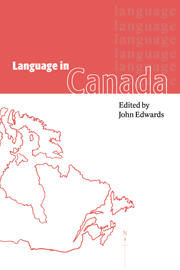Book contents
- Frontmatter
- Contents
- List of figures
- List of maps
- List of tables
- Notes on contributors
- 1 Canada
- Introduction
- 1 The foundations
- 2 The fading Canadian duality
- 3 Official bilingualism: from the 1960s to the 1990s
- 4 Official multiculturalism
- 5 Language in education: bridging educational policy and social psychological research
- 6 Aboriginal languages: history
- 7 Aboriginal languages: current status
- 8 French: Canadian varieties
- 9 French in Quebec
- 10 French in New Brunswick
- 11 French outside New Brunswick and Quebec
- 12 English: Canadian varieties
- 13 English Quebec
- 14 The teaching of international languages
- 15 French immersion in Canada
- 16 Language in Newfoundland
- 17 Language in Prince Edward Island
- 18 Language in Nova Scotia
- 19 Language in New Brunswick
- 20 Language in Quebec: aboriginal and heritage varieties
- 21 Language in Ontario
- 22 Language in Manitoba
- 23 Language in Saskatchewan: Anglo-hegemony maintained
- 24 Language in Alberta: unilingualism in practice
- 25 Language in British Columbia
- 26 Language in the Northwest Territories and the Yukon Territory
- Index of names
- Index of language families, languages, dialects
- Index of subjects
19 - Language in New Brunswick
Published online by Cambridge University Press: 18 February 2010
- Frontmatter
- Contents
- List of figures
- List of maps
- List of tables
- Notes on contributors
- 1 Canada
- Introduction
- 1 The foundations
- 2 The fading Canadian duality
- 3 Official bilingualism: from the 1960s to the 1990s
- 4 Official multiculturalism
- 5 Language in education: bridging educational policy and social psychological research
- 6 Aboriginal languages: history
- 7 Aboriginal languages: current status
- 8 French: Canadian varieties
- 9 French in Quebec
- 10 French in New Brunswick
- 11 French outside New Brunswick and Quebec
- 12 English: Canadian varieties
- 13 English Quebec
- 14 The teaching of international languages
- 15 French immersion in Canada
- 16 Language in Newfoundland
- 17 Language in Prince Edward Island
- 18 Language in Nova Scotia
- 19 Language in New Brunswick
- 20 Language in Quebec: aboriginal and heritage varieties
- 21 Language in Ontario
- 22 Language in Manitoba
- 23 Language in Saskatchewan: Anglo-hegemony maintained
- 24 Language in Alberta: unilingualism in practice
- 25 Language in British Columbia
- 26 Language in the Northwest Territories and the Yukon Territory
- Index of names
- Index of language families, languages, dialects
- Index of subjects
Summary
INTRODUCTION
As Canada's only officially bilingual province, New Brunswick retains – in demographic, geographical, linguistic and cultural terms – the duality of the Acadian and Loyalist groups who were the first European immigrants to settle in the Maritime region. About two-thirds of the population is English-speaking; the remainder speak French as a first language. The French-speaking population is concentrated along the northern and eastern sides of the province, from Grand Falls to the Quebec border, along the north shore, and south towards Nova Scotia along the Gulf of St Lawrence coast. The English-speaking population lives mainly in the area bounded by Maine and the Bay of Fundy, extending eastward to Sussex and Sackville and north to the Miramichi watershed. In each of these two areas there are also communities where the ‘other’ language predominates. Linguistically, the province maintains separate school systems for the two groups, although every school district enrols children from both groups. Each district also offers instruction in English or French as a second language, either through the popular French immersion programmes or in classes where the language is taught as a subject. Similarly, at the post-secondary level, the Université de Moncton attracts primarily francophone students, while the student population at the University of New Brunswick and Mount Allison and St Thomas Universities is mainly anglophone; the same may be said of the many community colleges in the province.
- Type
- Chapter
- Information
- Language in Canada , pp. 372 - 383Publisher: Cambridge University PressPrint publication year: 1998

